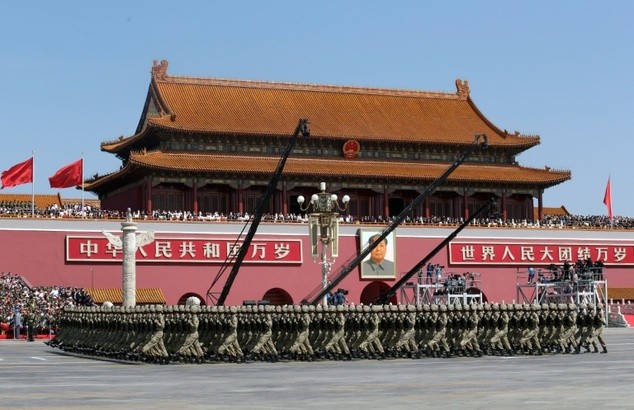
- Reuters reports: "China's defense budget this year is likely to rise at its slowest pace since 2010, in line with the decelerating economy and by a much lower figure than had been expected in military and diplomatic circles....Fu Ying, spokeswoman for China's parliament, said the figure would increase by about seven to eight percent from 2015, following a nearly unbroken two-decade run of double-digit budget increases....It will be the first single-digit rise in spending since 2010, when the military budget logged a 7.5 percent increase."
The Navy Times reports that the U.S. Navy has dispatched a small armada to the South China Sea.The carrier John C. Stennis, two destroyers, two cruisers and the 7th Fleet flagship have sailed into the disputed waters in recent days, according to military officials. The carrier strike group is the latest show of force in the tense region, with the U.S. asserting that China is militarizing the region to guard its excessive territorial claims. Chinese officials dismissed claims that China was militarizing the region, pointing to the Stennis's patrol as evidence that the U.S. was to blame for the increased military tensions."The accusation [that China is militarizing the region] can lead to a miscalculation of the situation," said Fu Ying, a spokeswoman for China's National People's Congress. "If you take a look at the matter closely, it's the US sending the most advanced aircraft and military vessels to the South China Sea."
Bloomberg says that the International Monetary Fund said it will start identifying the yuan in its official foreign-exchange reserves database starting in October, advancing China's push for a bigger international role of its currency, which is also known as the renminbi.The listing will enable IMF members "to record as official reserves their holdings of renminbi-denominated external assets that are readily available for meeting balance of payments financing needs," the Washington-based lender said Friday in a statement. The change will be reflected in the IMF's fourth-quarter survey on the currency composition of official foreign-exchange reserves, known as Cofer, that covers a total of 96 countries. That survey will be published at the end of March, 2017.China is seeking a more prominent role in the global economy and showcased its stature when it hosted a meeting of the Group of 20 last month.
- 2016-03-03 Five Things to Know About China’s ‘Two Sessions’
- 2016-03-02 China testing Obama as it expands its influence in Southeast Asia
- 2016-03-01 Exclusive: China to lay off five to six million workers, earmarks at least $23 billion
- 2016-02-29 China expects to lay off 1.8 million workers in coal, steel sectors
- 2016-02-28 Dodging Critics & Soothing Fears, China Meets G-20 Goals
- 2016-02-26 China talks up growth agenda at G20 amid lack of wider policy unity
- 2016-02-25 U.S., China Agree to Sanction North Korea on Nuclear Program
- 2016-02-24 China says media ignores other claimants' weaponry in South China Sea
- 2016-02-23 China Appears to Have Built Radar Facilities on Disputed South China Sea Islands
- 2016-02-22 Beijing to Raise Threshold on Red Alerts for Smog
- Reuters China's 2016 defense budget to slow in line with economy
- BBC News One of five missing Hong Kong booksellers returns from China
- The New York Times Tibetan Monk, 18, Dies After Self-Immolation to Protest Chinese Rule
- The Washington Post China's military, like its economy, isn't really winning right now
- CBS News China returns fire at U.S. as war-of-words escalates
- Reuters China small caps plunge but banks jump; Hong Kong follows global markets up
- The Washington Post How China's transforming military, especially in air, at sea
- The Economist Big bother
- Bloomberg Business China Said to Intervene in Stocks Ahead of Annual Policy Meeting
- TIME China's Censors Are Leaving the World's Most Populous Nation With Very Little to Watch on TV
- Reuters China orders 'blacklist' of 31 North Korean vessels: document
- The Washington Post Navy aircraft carrier group moves into contested South China Sea
- The New York Times: Sinosphere As China's '2 Sessions' Convene in Beijing, Delegates Are Wary
- The Wall Street Journal: China Real Time Making Waves: In Blow to Foreign Films, China Gives 'Mermaid' Three-Month Boost
- The Diplomat China's Two-Child Policy: What Next?
- The New York Times: Sinosphere Q. and A.: How China's National People's Congress Works
- The Wall Street Journal: China Real Time Beijing Has China's Best Environment for Startups, New Survey Says
- The Diplomat South China Sea Update: China and Philippines Face Off Over Jackson Shoal
- Reuters Chinese tycoon's U.S. movie merger has rare logic